.

Images credit: NASA, via Kitt Peak National Observatory (visible, top) and Spitzer (IR, below).
-
When we look out at the Universe, our view is pretty consistently dominated by the stars within our own galaxy. Although we know that many interesting things lie beyond — globular clusters, individual galaxies, and rich clusters and superclusters of galaxies — being in the Milky Way makes it very hard to see a great many of them. This is because our own galaxy, from our vantage point within it, dominates a huge fraction of the sky overhead.
.

Image credit: ESO/B.Tafreshi, of the Milky way in visible light as seen from Earth.
-
The plane of the Milky Way itself obscures about a total of 20% of our night sky. What appears to be a white streak is actually the light from billions upon billions of stars whose light appears to blend together from our point of view, while the dark nebulae are actually neutral clouds of gas-and-dust that appear in the foreground, blocking the light that comes from behind.
At least in the wavelengths of light visible to our own eyes, this is an incredibly severe effect.
.

Image credit: GigaGalaxyZoom, via the European Southern Observatory.
-
For a long time, the plane of our galaxy prevented us from seeing very much of anything that lay beyond it. Termed the Zone of Avoidance, searches for distant galaxies and nebulae turned up very few results in this 20% of the sky, while our discoveries elsewhere simply grew and grew. While we were discovering a plethora of objects beyond the galaxy in all other directions, surveying the portion of the night sky that was blocked by our own galaxy was prohibitive. The light-blocking power of the intervening matter — known as extinction — was simply too much to overcome.
And this would still be true coming all the way up to today if we confined ourselves to the light that our own eyes can see. Thankfully, however, we now know better.
.

Image credit: E. L. Wright (UCLA), The COBE Project, DIRBE, NASA, via http://apod.nasa.gov/apod/ap000130.html.
-
The inset image was the very first picture of the entire sky taken in the infrared, thanks to the COBE satellite’s DIRBE instrument. (And yes, the “IR” in DIRBE stands for infrared.) The final results from COBE led to the main image, where many more stars are visible. You’ll note that the light-blocking effects are tremendously reduced, which is a function of the fact that the “dust” that blocks visible light are actually particles of a certain size, and that size is much less efficient at blocking the longer-wavelength infrared light!
An even sharper view — in more wavelengths — has been provided by the two-micron all-sky survey (2MASS), as you can see below.
.
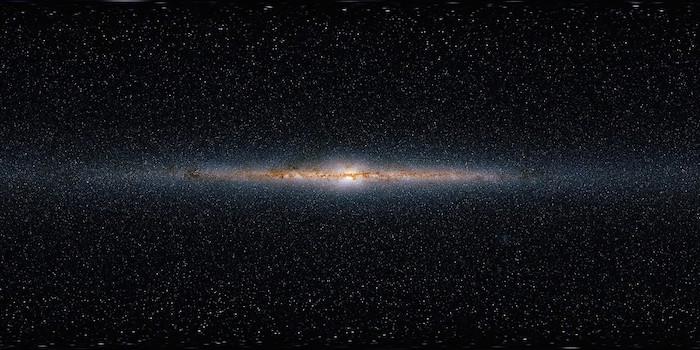
Image credit: 2MASS / J. Carpenter, T. H. Jarrett, & R. Hurt.
-
As you can tell, the light-blocking gas and dust has practically disappeared, and that’s no coincidence. Although we don’t normally think about it, the wavelengths of all types of light that interact with something is highly dependent on the size of the object itself. This is why there are large holes on your microwave door: they allow visible light through but block the microwaves that cook and heat your food. (Don’t scrape the holes off, not even in the interest of science!)
And as we noted earlier, for the dust grains in our galaxy, visible light is easily absorbed while infrared passes through uninhibited. This is specific to the types of molecules and how they’re bound together in the interstellar medium.
.
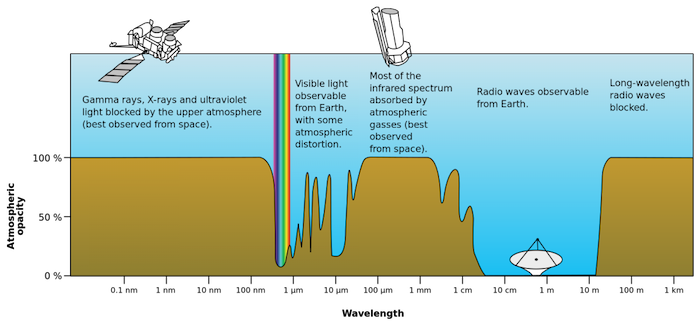
Image credit: NASA (original); SVG by Wikimedia Commons user Mysid. This shows the atmospheric opacity at different wavelengths.
-
If we take a look at our atmosphere instead, the converse is true: visible light passes through the molecules and particles present very easily, while infrared is more easily absorbed. That’s why, to really get a handle on what’s out there beyond the plane of our galaxy, we can’t do it from the Earth’s surface; the atmosphere’s infrared light-blocking properties are simply too good.
To look beyond our galactic plane, and spy the Universe beyond, we simply have to go to space. Lucky for you, we have, and the results are mind-blowing.
.
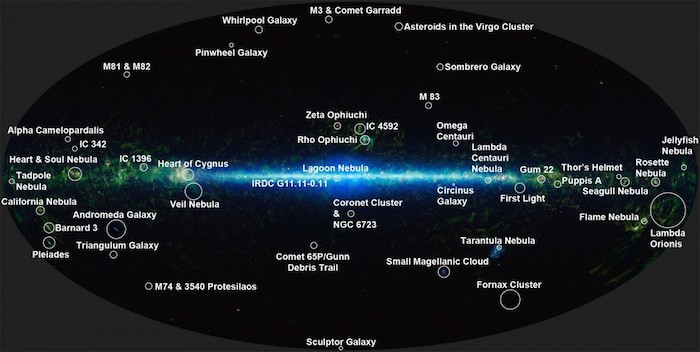
Image credit: NASA / JPL-Caltech / WISE Team.
-
The warm gas actually leaves an infrared signature, as seen in green fromthis all-sky mosaic in the infrared from WISE. What’s really interesting, though, is that even with the warm gas, we can still find out what lies behind a large amount of the galactic plane from a survey like this. In fact, if you zoom in (they have a zoomable version) on the region marked IC 342 up there, you’ll find a number of really interesting features.
.

Image credit: NASA / JPL-Caltech / WISE Team.
-
For starters, IC 342 is itself one of the most interesting objects in the night sky. It should come as no surprise that Andromeda is the largest galaxy outside of our own as seen from our vantage point, followed by theTriangulum Galaxy, M33, which also lies within our local group. But what might surprise you is that the third largest galaxy as seen from our location is actually this rarely-seen galaxy, IC 342 (just left of the image center), which wasn’t even first discovered until 1895!
Thankfully, WISE also imaged it at a far higher resolution than this wide-field mosaic shows, revealing a familiar spiral structure.
.
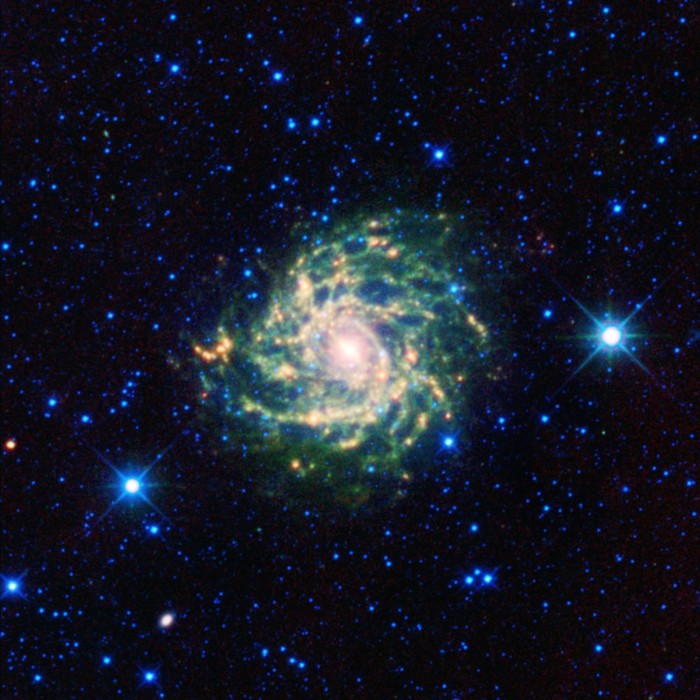
Image credit: NASA / JPL-Caltech / WISE Team.
-
When it was discovered in 1895, there were not yet any such thing as an infrared telescope, and there certainly wasn’t an infrared telescope in space, as we hadn’t even developed the airplane at that point!
As it turns out, this galaxy can be seen in visible light, it’s just very dim, and partially obscured by dust and by foreground emissions. Even the Hubble Space Telescope, for all its power, can only obtain an image that pales in comparison to the infrared shots that an observatory like WISE can take.
.
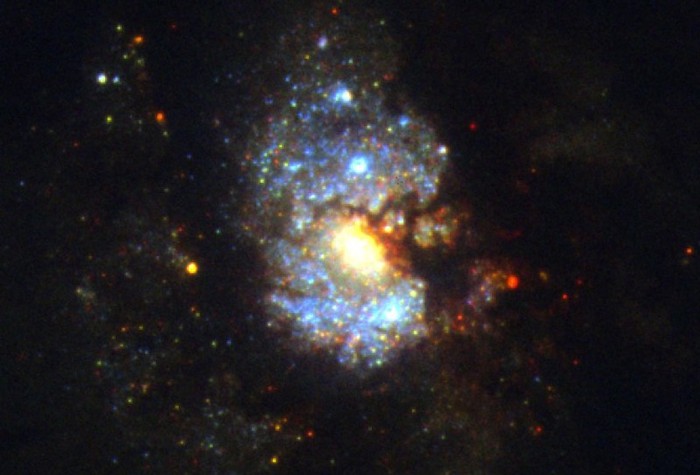
Image credit: NASA / ESA / Hubble Legacy Archive, of IC 342, edited by me.
-
Not only does the dust obscure the visible light, but it makes it extremely dim. If the Milky Way weren’t there, not only would this galaxy be bright and prominent, but it would also quite likely be visible to the naked eye, even though it lies far beyond the local group at an estimated 10 million light-years distant. (About five times as distant as Andromeda.)
What’s maybe even more interesting is that there are tons of galaxies in the Zone of Avoidance that we just missed, for centuries, because of this exact problem, including many of the closest galaxies to our own!
.

Image credit: NASA / JPL-Caltech / WISE Team.
Nearby IC 342, in the same region of the sky, you can see two prominent galaxies shining through some of the warm dust of our own Milky Way. If we zoom in, you can see a distorted spiral galaxy and a giant elliptical in far greater detail.
.

Image credit: NASA / JPL-Caltech / WISE Team.
-
These galaxies are named Maffei 1 (for the elliptical) and Maffei 2 (for the spiral), after their discoverer, the Italian astronomer and infrared pioneer,Paolo Maffei. These are two of the intrinsically brightest galaxies close by, and in fact Maffei 1 is the single closest giant elliptical galaxy to us in all the Universe.
And yet, they weren’t even seen for the first time until 1967, due to the tremendous obscuring power of the Milky Way’s dust!
.

Images credit: Maffei 1 and 2, by the Hubble Legacy Archive / NASA / ESA, edits by E. Siegel.
-
More than 99.5% of the light from these galaxies are obscured by the intervening Milky Way; if not for our unfortunate galactic orientation, Maffei 1 (above left) would definitely be visible to the naked eye alone, despite being some 10-to-13 million light years distant! Although Maffei 2 wouldn’t be, it’s still gorgeous and worthy of study in its own right, and so different in the visible as compared with the infrared!
So if you were asking yourself what the Universe really looks like, and you saw the quite popular image (below), don’t be fooled.
.

Image credit: Cosmic Flows Project/University of Hawaii, via http://www.cpt.univ-mrs.fr/.
-
What we call “the Zone of Avoidance” isn’t, as we commonly present it, a nearby region with very few galaxies. Although we’ve seen very few galaxies, in reality it’s most probably a region with just as many galaxies as the rest of the Universe, that just happens to be hard to see from our vantage point!
The detailed observations that have been made of Maffei 1 teach us something incredibly valuable. You see, there’s a myth going around that if you — a human being — were placed at a random location in the Universe, irrespective of planets, stars, or galaxies, you most likely wouldn’t be able to see anything. Not a single star or galaxy would be bright enough to capture with your naked eye.
.
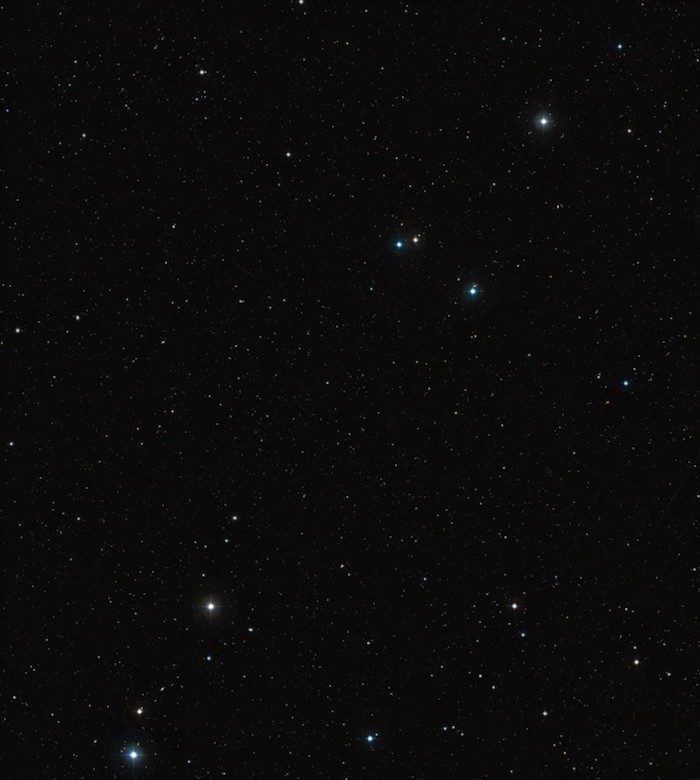
Image credit: ESO/ Digitized Sky Survey 2, via http://www.eso.org/public/images/eso1019b/.
-
That’s simply not true. While it is true that there are some locations — like in the middle of great, cosmic voids — for which you wouldn’t be able to see anything, galaxies like Andromeda, Bode’s Galaxy and Maffei 1 are abundant enough and spread out enough that the odds are at least one such galaxy (and more than that, on average) would be visible to you from any random location.
And that means your view from outside a galaxy, at a random location of the Universe, you would still have a very good chance of being within viewing distance of the bright monsters of the Universe.
.
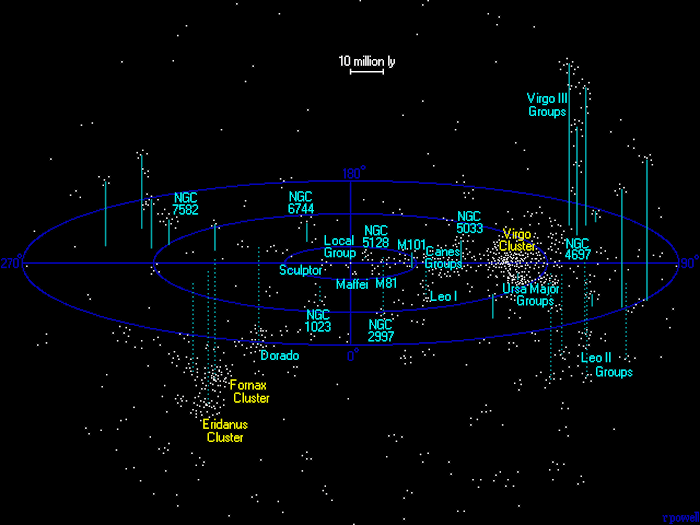
Image credit: Richard Powell / Atlas of the Universe.
-
Without any galactic dust (or atmospheric extinction, for that matter) to obscure your views of the Universe beyond, you’d be able to see at least something from almost anywhere, even with your pathetic unaided eyes.
But even from our location, there’s a great lesson to be learned: if you want to see what lies beyond our galaxy — or any dusty galaxy — just look in the infrared, and watch the Universe open up to you! And as a reward for making it all the way to the end, enjoy this huge, high-resolution slideshow of the galactic plane, courtesy of NASA’s Wide-field Infrared Survey Explorer. Enjoy!
Quelle: Forbes4186 Views
